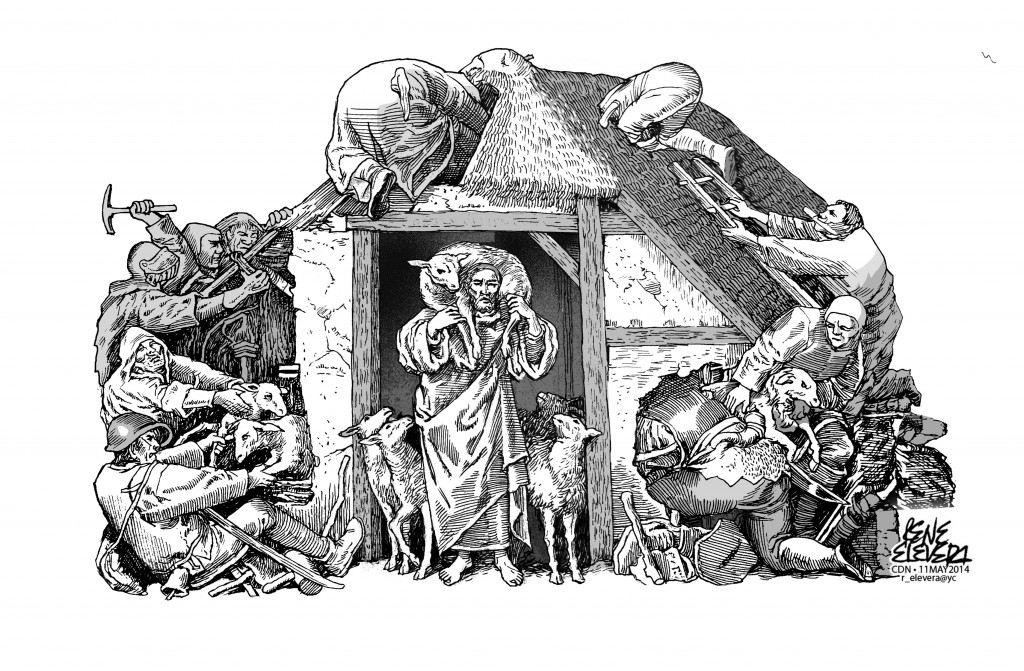Not the least among the works of Pieter Bruegel the Elder were his prints. Of these one worthy of mention is “The Parable of the Good Shepherd.” The work shows Christ as the Good Shepherd at the doorway of a sheepfold. On his shoulder he carries an ewe.
The other sheep crowd around him. High on the roof and through the sides of the sheep-gate thieves break into the sheepfold. Elsewhere are sheep-tending scenes. Rather than drive them away, Christ seems to tolerate the thieves.
He looks determined, however, and is in full control. Borne on the Lord’s shoulder the ewe is the picture of contentment. Innocence characterizes the sheep. Loping seems to be in their minds, and enjoyment generally. Love thrives despite the dangers.
Obviously, Bruegel’s work directs us to the passage in John, in which Jesus said, “Amen, amen, I say to you, whoever does not enter a sheepfold through the gate but climbs over elsewhere is a thief and a robber. But whoever enters through the gate is the shepherd of the sheep.
The gatekeeper opens it for him, and the sheep hear his voice, as he calls his own sheep by name and leads them out. When he has driven out all his own, he walks ahead of them, and the sheep follow him, because they recognize his voice. But they will not follow a stranger; they will run away from him, because they do not recognize the voice of strangers.”
When the people did not understand this, Jesus added, “Amen, amen, I say to you, I am the gate for the sheep. All who came [before me] are thieves and robbers, but the sheep did not listen to them. I am the gate. Whoever enters through me will be saved, and will come in and go out and find pasture. A thief comes only to steal and slaughter and destroy; I came so that they might have life and have it more abundantly.”
In Bruegel’s piece, everything seems to be happening at once–Jesus passing through the gate with the ewe even as the folk attend to the sheep and thieves creep through the holes that they made on the sides and roof of the gate.
Were it not a representation of a biblical passage, the scene would be another of Bruegel’s depictions of peasant life, for which, together with his landscapes, we mostly remember him. In fact, Bruegel was known as The Peasant–not only did he celebrate the peasantry in his art, he moreover dressed himself up as one to bond with the country folk.
Bruegel was basically a story teller. Instead of just portraying a moment of tendresse between the Good Shepherd and the sheep, as in many a devotional painting, he included as many of the activities mentioned in the parable as could be accommodated, which is why we see alongside Jesus the Good Shepherd the thieves and robbers entering through the roof and sides and stealing the sheep.
It seems that Bruegel really wants us to suspend the sense of immediacy in visual perception and view the incidents in the picture as happening at different times, say, to consider the Good Shepherd as passing through the gate in the absence of thieves, and the thieves breaking in in the absence of the Good Shepherd, who would naturally fight to stop the sheep being stolen or led away and slaughtered.
And yet, on another level, all of the activities may be taken as synchronous, at once happening together. In fact, the parable may be renamed the parable of the moment, time’s equivalent of the sheep-gate, with its promise both of opportunity and risk, loss and gain. The present offers a savior, a friend, and also a foe–the Good Shepherd, and also the thief.
Whether it is the Good Shepherd or the thief, whether I will be carried on the shoulders or snatched and clipped bleating within the armpits to be slaughtered in the fields, this depends on me.
The revolving carousel in Chinese restaurants, arrayed with platters of different dishes, from which the customers who sit around choose what to eat, fascinates me. They suggest to me the way I can always be serene and happy.
The mind–another sheep-gate–is of the nature of this carousel. Thoughts continuously stream through it, every one of them with a potential to affect–either to elate or sadden, to annoy or please, to build up or destroy, to save or damn.
But now I just reflect on the carousel, and choose only those that are conducive to peace and, well, love.
Choice is the word. Actually, voice–the small, still voice within, the voice of the Good Shepherd.
